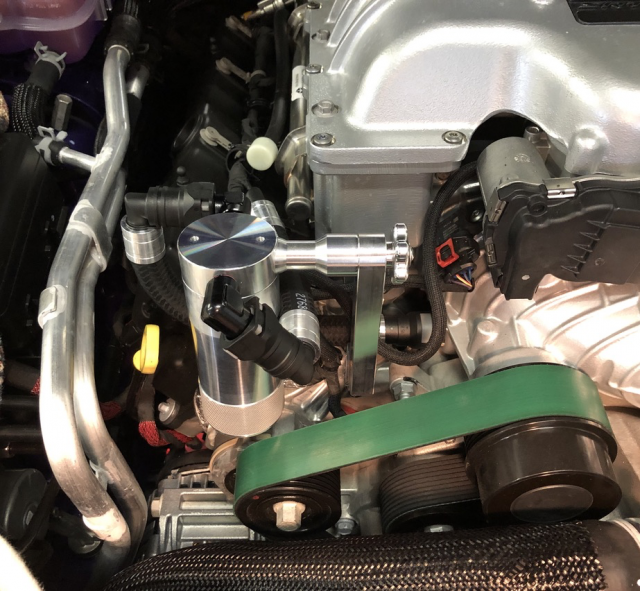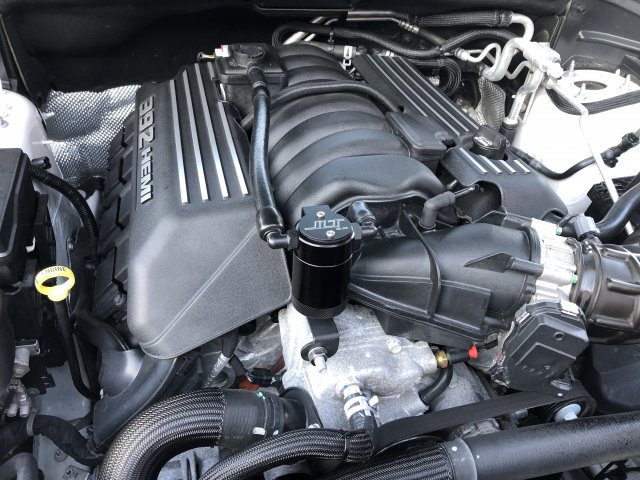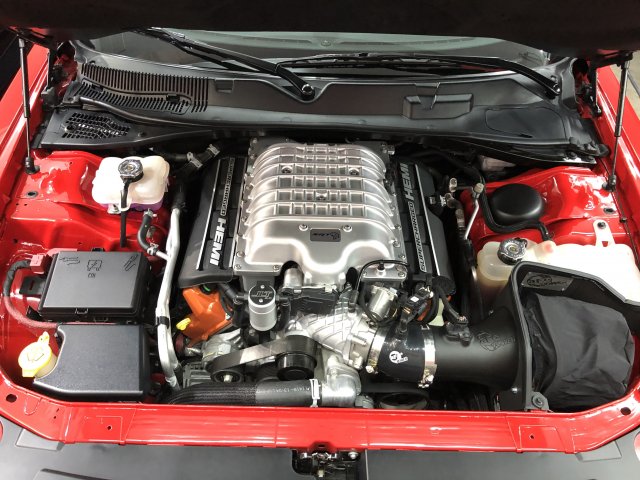-
Sign Up! To view all forums and unlock additional cool features
Welcome to the #1 Dodge, Jeep and RAM Forum dedicated to FCA owners and enthusiasts. Register for an account, it's free and it's easy, so don't hesitate to join the SRT Forum today!
Catch Can; how is yours?
- Thread starter DGatzby
- Start date
- Member ID
- #1155
- Messages
- 11,913
- Reactions
- 20,159
- Likes
- 352
- City
- West Texas
- State
- TX
- Country
- United States
- Vehicle
- 2017 Charger HC (once upon a time)
- Member ID
- #2078
- Messages
- 349
- Reactions
- 552
- Likes
- 67
- City
- Morning View
- State
- KY
- Country
- United States
- Vehicle
- 2019 Challenger Hellcat Redeye Wide Body
Good article, but the author recommends one on the passenger side and possibly another on the driver side. Everything I've read on HC websites by folks that have done both say the driver side never catches anything.
I thought it was a good article too. Definitely thought-provoking.
I also read a post or two to the effect a driver's side catch can doesn't catch oil - which I understand from the article is inserted into the "makeup air line" running between the driver's side engine valve cover and the air filter. This makeup air line normally lets clean fresh air into the crankcase. It used to be called a "Breather" - and it is just a way to allow fresh air into the crankcase to replace blowby gases being recirculated into the intake manifold.
According to the article a second catch can will catch oil from any crankcase blowby that had reversed the makeup air line's normal flow. That could happen if an engine, especially a supercharged engine, running at high RPM (WOT) generated so much intake manifold pressure it exceeded the blowby air pressure coming out of the crankcase ventilation side gas line (where most people with catch can fever like me have put them). The PCV valve in that blowby line becomes "overstimulated" and temporarily closes, or it could just fail closed (we should get a check engine light if that happened). Whether just too much ventilation line back pressure or a failed PCV valve the crankcase begins to overpressurize. If that happens without an air outlet somewhere else the crankcase would overpressize to the point we'd blow gaskets and seals and develop chronic oil leaks - exactly what happened in the old days of the early gasoline internal combustion engines before they started venting the crankcases to the open air. So where does the air vent today when this happens? Out the makeup air line, which in modern cars is routed into the air intake box where dirty blowby gases can be sucked back into the engine and burned (as opposed to being vented to the atmosphere). This temporary overpressure condition is why the author of the Arrington Performance article recommends a second catch can, among other things like removing the PCV valve and installing bigger hoses.
Nice explanation of modern PCV purpose and function here;
https://en.wikipedia.org/wiki/Crankcase_ventilation_system
And this excerpt from;
https://www.aa1car.com/library/pcv.htm
...has a nice section below. Above this excerpted section aa1car.com states, "WARNING: Removing or disconnecting the PCV system in an attempt to improve engine performance gains nothing, and is illegal. EPA rules prohibit tampering with any emission control device. Disabling or disconnecting the PCV system can also allow moisture to accumulate in the crankcase, which will reduce oil life and promote the formation of engine-damaging sludge."
That was easy - not ever going to remove the PCV valve!
"HOW PCV FLOW CHANGES WITH ENGINE SPEED & LOAD
The flow rate of a PCV valve is calibrated for a specific engine application. For the system to function normally, therefore, the PCV valve must adjust the flow rate as operating conditions change.
When the engine is off, the spring inside the valve pushes the pintle shut to seal the crankcase and prevent the escape of any residual vapors into the atmosphere.
When the engine starts, vacuum in the intake manifold pulls on the pintle and sucks the PCV valve open. The pintle is pulled up against the spring and moves to its highest position. But the tapered shape of the pintle does not allow maximum flow in this position. Instead, it restricts flow so the engine will idle smoothly.
The same thing happens during deceleration when intake vacuum is high. The pintle is pulled all the way up to reduce flow and minimize the effect of blowby on decel emissions.
When the engine is cruising under light load and at part throttle, there is less intake vacuum and less pull on the pintle. This allows the pintle to slide down to a mid-range position and allow more airflow.
Under high load or hard acceleration conditions, intake vacuum drops even more, allowing the spring inside the PCV valve to push the pintle valve even lower to its maximum flow position. If blowby pressure builds up faster than the PCV system can handle it, the excess pressure flows back through the breather hose to the air cleaner and is sucked back into the engine and burned.
In the event of an engine backfire, the sudden rise in pressure inside the intake manifold blows back through the PCV hose and slams the pintle shut. This prevents the flame from traveling back through PCV valve and possibly igniting fuel vapors inside the crankcase."
Here is a picture of my Red Eye's aftermarket UPR catch can. The PCV valve is downstream of this ventilation side catch can so it arguably stays cleaner than without a catch can. There IS an internal air/oil separator for our Hemi engines BTW. But we still see that an external aftermarket one collects oil which otherwise would go back in the intake and mix with air and fuel. That being in the ungood category.

Here's an excerpt from the Arrington Performance article. Later in this article the author recommends that supercharged or turbocharged engines have their PCV valves removed and also recommends a dual catch can configuration. Maybe he's thinking pure race cars about the PCV valve.
https://www.shophemi.com/images/media/p-2273-arrington_ccv_bible.pdfis
From Page 9 and 10, my bolding of text...it restates what I said in my first paragraph.
"Another important feature of the PCV valve is that it acts as a “check-valve” in that it will (generally) not let flow go the wrong direction. That is to say, it will not let air flow towards the crankcase. Instead, it closes the Ventilation Line off completely. I hope that you guys with centrifugal superchargers or turbochargers realize how this impacts you.
Here is the big, dramatic moment of realization on PCV valves – a PCV does not know what “vacuum” is. It only knows, and only responds to pressure differential. Why is that a big deal? Well, the PCV plunger responds by closing when the pressure on the “intake” side is lower than the pressure on the crankcase side. This happens either when the intake is under vacuum, OR when the crankcase builds pressure. Because a high-output engine flows so much blow-by gas volume through such a small line, and because the PCV valve often represents a point of restriction in that line, you can build enough pressure in the crankcase that – even with no vacuum in the intake – you will make the PCV valve close because it thinks it’s seeing vacuum! That is not a good thing!
Okay, maybe I get overly excited about this stuff, but that is a very significant tidbit of information. When your engine is running at maximum load – maximum torque output – and when you’re generating the most blow-by gas, your PCV valve is very likely being “over stimulated” and shutting down completely.
So, what happens then? Well, the blow-by gas must find a way out of the crankcase, and it finds the way out through the makeup air line. This condition is referred to as a “foul-air condition” and is bad for several reasons (besides just sounding bad):
1) If your engine does have a built-in air-oil separator (or catch can - says Finface), it is being bypassed in this mode – you are shooting untreated blowby gas (in reverse flow out the makeup air line) right into your intake ("untreated" is not 100% true, says Finface, because the blowby gas does go through the regular air filter which should scrub some of the oil).
2) The engine is no longer replenishing crankcase gas with fresh air, you’re pushing blow-by gas in and letting it push right back out.
3) Because the makeup air line is likely not sized properly for the volume the engine is flowing in this condition, the crankcase is likely building some amount of pressure and, thus, robbing the engine of power. (It does this, literally, by air pressure in the crankcase pushing up against the underside of the pistons, says Finface, who read that somewhere)
So, foul-air condition represents a breakdown of the CCV system and is, therefore, a bad thing. Another important tidbit here – many (possibly even most) high-performance engines will encounter foul-air condition even in bone stock, factory trim. Figure 6 shows a typical, representative pair of curves showing how blow-by generation and PCV valve flow compare. You can see that in most cases, the PCV valve will flow more than enough. But at high load and high RPM, the PCV loses its little spring-loaded mind and starts to shut down, pushing the engine into a foul-air condition.
For those of you, who have already installed a catch-can on the Ventilation Line, I bet you didn’t realize that when you’re hard on the throttle, that line is shut down for business."
End of article excerpt. Finface's take...DGatzby's thread on a ventilation side catch is relevant. I think they're worth it. We see they work on the ventilation line. Blowby gases recirculating into the intake manifold to be burned do have less oil droplets in them. Why aren't they standard equipment? Something the car owner would have to maintain between oil changes (and some negligent owners might go 12,000 miles or more between changes) or else liquid oil could begin to be extracted from the catch can and that would really gunk the engine up, plus for most owners the blowby oil residue never becomes a big issue (how many really run at WOT?), plus expense. These are reasons other posters have mentioned in other threads.
As jroyk pointed out, owners with driver's side catch cans installed on the makeup air line report they are not doing much oil catching - even if/when our PCV valves are likely closing during WOT and forcing blowby gases out the makeup air line in a temporary reverse "foul air" flow situation. Any oil getting that far upstream in these temporary reverse air flow situations is being blended with fresh air and going into the intake manifold. Maybe because makeup air line flow is 99% of the time going in normal "into the crankcase" flow direction to maintain positive pressure any oil that might get caught in these catch cans during WOT operation more or less evaporates. So this Arrington Performance article from late 2011 goes beyond just catching oil on the ventilation line side to prevent it going back into the intake manifold. The author is making the case that stock supercharged engines come equipped with ventilation and makeup air lines that cannot handle WOT blowby combined with high intake manifold pressures. He's saying we need both ventilation side and makeup air side catch cans, AND a larger air hose on the makeup air line in order to keep blowby gases and oil out the air filter, and the intake manifold, where it gets on the tops of the pistons and other undesirable places, AND that if we had a larger makeup air line that could handle the overflow from the ventilation side's inadequacies we'd not see our engines robbed of power due to crankcase overpressuriztion. How true is this? If true, how serious is this? Arrington Performance sells larger hoses and catch cans - perhaps the impetus for the article in the first place?
I'm tempted to install a catch can on the makeup air line before next year's HPDE events and see for myself if any oil collects. It might do some good. Maybe posters aren't seeing collected oil in that driver's side catch can because WOT for 15 seconds times six or seven quarter mile runs a session at a drag strip isn't long enough reversal of makeup line pressure to matter. I'm wondering if what DGatzby and I are doing - prolonged HPDE road course driving - which has us (well, him more than me) at WOT repeatedly during 20-30 minute runs, times four or five of these sessions per HPDE day, would result in no oil collecting.
Here's a thought DGatzby! Maybe I'm getting more oil collected in my ventilation side catch can than you because you are running WOT way more than me during HPDE. Because you're a maniac setting personal lap records and I'm still a Novice Class driver. Your WOT operation could be closing your PCV valve more than my WOT operation, blocking your engine's blowby gases from flowing through your catch can. When this happens you are reverse flowing blowby gases (with oil droplets) out your makeup air line and feeding them back into your intake manifold via your air filter - instead of catching oil on that side of the engine! Hey, that MIGHT even be true *grin*! As we like to say here in Kentucky, "Just stands to reason..."
Best,
Finface
-
1
-
1
- Show All
- Member ID
- #1140
- Messages
- 1,031
- Reactions
- 1,345
- Likes
- 162
- City
- Hillsborough
- State
- NC
- Country
- United States
- Vehicle
- 2016 Challenger Hellcat
OK. Now do one where the actual negative effects on KR and performance are documented. 
The catch-can debate has been theory, and it IS a decent theory, occasionally supplemented by a picture of a dirty intake. I'd love to see a long term test that included data on this stuff, but it's easier to pitch softballs and make some money, in my opinion. Getting someone to datalog a beat-on car for 60k (70? 80?) is simply unlikely. Half the owners barely leave the garage.
The catch-can debate has been theory, and it IS a decent theory, occasionally supplemented by a picture of a dirty intake. I'd love to see a long term test that included data on this stuff, but it's easier to pitch softballs and make some money, in my opinion. Getting someone to datalog a beat-on car for 60k (70? 80?) is simply unlikely. Half the owners barely leave the garage.
-
1
- Show All
- Member ID
- #1045
- Messages
- 478
- Reactions
- 1,043
- Likes
- 117
- City
- Houston
- State
- TX
- Country
- United States
- Vehicle
- Porsche GT3
Mine does. Most folks use them on the p/s side and seem to get results with minimal result, if any, on the d/s. Here’s my JLT.
View attachment 27868
Off topic, where'd you get the "Air Grabber" decal? I'd like one of those...
- Member ID
- #1198
- Messages
- 2,594
- Reactions
- 7,158
- Likes
- 302
- City
- Long Island
- State
- NY
- Country
- United States
- Vehicle
- 15 Hellcat Challenger
- Member ID
- #1139
- Messages
- 3,703
- Reactions
- 8,724
- Likes
- 252
- City
- Nanticoke
- State
- PA
- Country
- United States
- Vehicle
- 2016 Challenger He’ll Cat
I have a question for guys with fender mount JLT's. The install videos show the lines from the pcv to the can are routed below both. It seems to me this could form a P-trap. Do you guys have to empty the line to the can when you empty the catch can?
(Just curious. I have a Billet Tech.)
(Just curious. I have a Billet Tech.)
I recently switched to Corn, On gasoline the contents of the can would be all oil, maybe 2 oz in 2000 miles of very spirited driving, I do allot of 1/4 pulls as I have the perfect spot right by home and with a M6 practice makes perfect. I switched to corn now it’s a white creamy like stuff very little oil and not very much of it. At last test leak down was only .5% per cylinder, 100psi applied 99.5 in cylinder.
The more boost you make the less you want oil in the mix as it contributes to detonation and build up on piston tops and combustion chambers which increases compression which also leads to detonation.
-
2
-
1
- Show All
Hunter
Poster Club Hall of Fame
Staff Team
Founding Member
Premium Account
U.S. Army Veteran
Donating Member
HFCOTM
- Member ID
- #957
- Messages
- 10,648
- Reactions
- 30,095
- Likes
- 402
- City
- Moss Point
- State
- MS
- Country
- United States
- Vehicle
- 2019 Challenger Hellcat
- HFCOTM
- View Images
- Member ID
- #1012
- Messages
- 483
- Reactions
- 831
- Likes
- 117
- City
- Great White North
- State
- MN
- Country
- United States
- Vehicle
- 2016 Dodge Challenger
- Member ID
- #1080
- Messages
- 4,847
- Reactions
- 25,731
- Likes
- 302
- City
- Clarksville
- State
- TN
- Country
- United States
- Vehicle
- 2015 Challenger Hellcat/2019 Challenger Redeye
- Member ID
- #1304
- Messages
- 475
- Reactions
- 4,621
- Likes
- 167
- City
- Jefferson City
- State
- MO
- Country
- United States
- Vehicle
- 10,R/T12YJKT,15SPS,16 HC,19RE,22 S/S
- Member ID
- #3219
- Messages
- 63
- Reactions
- 60
- Likes
- 17
- City
- ESTERO
- State
- FL
- Country
- United States
- Vehicle
- 18 Charger Hellcat
- Member ID
- #1214
- Messages
- 2,312
- Reactions
- 5,528
- Likes
- 302
- City
- Ocean Springs
- State
- MS
- Country
- United States
- Vehicle
- 2015 Challenger HC M6
Thanks to this thread and @Stormtrooper1320 my wife has a new catch can on her DSRT. She’s so excited about her very first mod!
Attachments
-
3.6 MB Views: 25
-
5
- Show All
- Member ID
- #1068
- Messages
- 10,407
- Reactions
- 34,579
- Likes
- 352
- City
- Bran
- State
- Non-US
- Country
- Romania
- Vehicle
- Panzerkampfwagen 150
Thanks to this thread and @Stormtrooper1320 my wife has a new catch can on her DSRT. She’s so excited about her very first mod!
-
4
- Show All
- Member ID
- #1121
- Messages
- 702
- Reactions
- 1,741
- Likes
- 132
- City
- Shrewsbury
- State
- PA
- Country
- United States
- Vehicle
- 2018 Challenger Indigo Blue Hellcat
I have a BT catch can on the passenger side. Ive had it fill up on my M6 392 between oil changes and sometimes only get half or 1/4 full depending on how I drove. Right now on my 1320 I have 1600 miles on this oil change and 3 passes at the track and its maybe 1/4 full. My 15 HC had less but still would fill it 1/4 to sometimes half way between oil changes.
-
1
- Show All
- Member ID
- #3705
- Messages
- 3
- Reactions
- 3
- Likes
- 2
- City
- Wadsworth
- State
- IL
- Country
- United States
- Vehicle
- 2015 Challenger Hellcat
-
2
- Show All
- Member ID
- #3416
- Messages
- 207
- Reactions
- 487
- Likes
- 67
- City
- Tallahassee
- State
- FL
- Country
- United States
- Vehicle
- 2023 Challenger Redeye Widebody Jailbreak
I have the JLT 3.0 that I pulled of my Challenger before I sold it. Let me know if you're interested.
View attachment 27862
and to answer the original question......I'd get about 1 oz. in between oil changes at 3k miles on the 6.4L.
View attachment 27862
and to answer the original question......I'd get about 1 oz. in between oil changes at 3k miles on the 6.4L.
-
2
- Show All
- Member ID
- #5356
- Messages
- 228
- Reactions
- 292
- Likes
- 37
- City
- Jacksonville
- State
- FL
- Country
- United States
- Vehicle
- 2020 Dodge Challenger R/T Shaker
I have a 2015 and mine has collected very, very small amounts of oil. Honestly I don't think it was worth the investment. I was just sick and tired of people freaking out when I'd open my hood and all I'd hear is..."Dude you better get a catch can!" "What no catch can, you are nuts"...etc...
So yea I got a freaking catch can, so shut yer piehole.
I put more value on the fact I don't have to hear people griping about me not having the stupid thing, over what actual value it has on the engine's life.
So yea I got a freaking catch can, so shut yer piehole.
I put more value on the fact I don't have to hear people griping about me not having the stupid thing, over what actual value it has on the engine's life.
- Member ID
- #975
- Messages
- 18,184
- Reactions
- 96,065
- Likes
- 402
- City
- Sketchy
- State
- MI
- Country
- United States
- Vehicle
- 2016 Challenger Hellcat M6
If these vehicles required a catch can, MOPAR would install one, no?
-
1
- Show All



